Contemporary Church History Quarterly
Volume 23, Number 3 (September 2017)
John S. Conway: engaged skeptic and skeptical activist
By Doris L. Bergen, University of Toronto
This article was originally published in Kirchliche Zeitgeschichte 27 no. 1 (2014), and is reprinted here with the kind permission of that journal. It had its origins as a presentation at the July 2013 “Reassessing Contemporary Church History” Conference held at the University of British Columbia, where members of the CCHQ editorial team and others also took the opportunity to pay tribute to John S. Conway, founder of CCHQ, on the occasion of his 85th birthday.
John Conway is an intellectual leader, an astute and indefatigable historian of the churches, and a trailblazer in the fields of modern German, modern European and international church history. As everyone who knows John is aware, he is also a generous mentor and loyal friend.[1] John Conway has a sharp sense of humour, and it would be fitting to open this essay with a joke or witticism. But the field in which we work does not easily lend itself to jokes, so I will offer only one illustration of Professor Conway’s sometimes irreverent and always unsentimental approach to life and to himself. A few years ago he told me over the telephone about a serious medical procedure he had just undergone. Rather than highlight the severity of the operation or draw attention to his own discomfort, he exclaimed, “They slit my throat!”
As an expert on the churches in National Socialist Germany, Conway has been interviewed for several documentaries. He appears in a widely circulated film entitled Stand Firm: Jehovah’s Witnesses Stand Firm Against Nazi Assault [2], and he also features in Martin Doblmeier’s award-winning 2003 film, Bonhoeffer.[3] These media appearances encapsulate several important qualities of Conway’s work and life and illustrate in a compelling way who he is. Although separated by seventeen years they show some striking similarities. In both interviews Conway emphasizes the importance of the First World War in shaping subsequent events. He also speaks in similar ways about Adolf Hitler and the churches, in both films displaying a combination of distance and proximity, a balance between scholarly detachment and moral engagement that characterizes all of his work. Also notable is Conway’s treatment of antisemitism, where in both cases he moves from a scholarly analysis of the past to a call for action and activism in the present.
The First World War
The importance of the First World War is evident throughout all of John Conway’s work. In his publications, in the books he has chosen to review over the years and in the many academic and public talks he has given, the theme of the war and its dreadful impact on European culture and society and on Christianity around the world recurs over and over again.[4] It was during the First World War, Conway insists, when church leaders on all sides of the conflict preached the jingoist credo of “Gott mit uns!” – “God is on our side!” – that the Christian churches sowed the seeds for the decay of their credibility throughout the twentieth century.[5]
But Conway communicates an even bigger point about the war. The core problem he engages is the violence of the world, the destruction that human beings wreak on one another. Religion has a particular place in this set of issues. As Conway sees it, the role of Christianity and of the churches as moral authorities creates a responsibility to guide people toward what is good and right, but instead during the First World War church leaders egged on the brutality. Rather than healing and strengthening the best potential in people, they were blinded and obstructed the moral vision of their members and followers. They misused their authority and in the process forfeited it. Conway’s anguish at the suffering the war unleashed on the world and the failure of the Christian churches in the face of it is palpable in everything he does. The problem as Conway conceptualizes it is as old as the church and worldwide, and as a result his work, though concentrated on Germany (and the two Germanys)[6], always has a global perspective.
Many details of Conway’s biography connect with this preoccupation with the First World War and the problems of violence and suffering. John Conway was a student at Cambridge University. He started off studying literature, a decision that followed in the footsteps of many famous scholars in his family. His grandfather, R. S. Conway (Robert Seymour Conway, 1863-1933), was a well-known classicist, famed, among other accomplishments, for the vicious reviews he wrote. (The many of us who have had our books reviewed by John over the years can be grateful that he did not inherit this characteristic).
John Conway switched to History apparently because he had a sense that it might be better able to provide tools to respond to the recent past, the Second World War (an opinion in which he differs from his daughter Alison Conway, a professor of literature in Canada).[7] The young John Conway did his compulsory military service in the postwar period when that cataclysmic conflict was still a raw wound. His father, also a Cambridge man, served as captain of the English rugby team and in the trenches during the First World War. It is not surprising that John Conway has an enduring interest in religion and war, including specifically in military chaplains, in all their contexts. For his work Germany has always been a major case to study[8], but the world as a whole is his real stage.
In 1955 Conway faced a major culture shock when he left Cambridge for his first academic position, at the University of Manitoba in Winnipeg, Canada. He had to return to England to submit and defend his dissertation, and on the boat back he met his future wife, Ann. Evidently Ann had embarked on her own Commonwealth adventure, with plans to go from Canada to India, Australia and other faraway destinations. Instead she married John, which brought other kinds of adventures, though they did include travel. The two of them and their children have always moved internationally: their son David divides his time between Mexico and Canada, and from there he works designing film sets for Hollywood.
John Conway has always been on the move. He was offered his next academic position, at the University of British Columbia in Vancouver, on a train, and one of his gifts to that institution was a travel scholarship for graduate students to go to Germany and Israel. (Historian Steven Schroeder was one of the recipients of this award).[9] Perhaps the most lasting evidence of Conway’s international scope is the newsletter he founded to connect people around the world with an interest in contemporary church history. Several decades and at least two changes in title later, it has thousands of subscribers spread across all continents.[10]
Distance and Moral Engagement
Conway’s most famous work, his book, The Nazi Persecution of the Churches[11], received considerable praise for its depth of research and clarity of judgment. But it was also criticized by reviewers, some of whom deemed it too harsh, others of whom accused Conway of being too forgiving of the Germans. This divided response brings to mind Isaiah Berlin’s essay on Ivan Turgenev, the author of Fathers and Sons. Turgenev, Berlin maintained, proved himself to be a genuine moderate and a true liberal because he was attacked from both sides.[12] In Conway’s case, that two-pronged attack offers evidence that he is a genuine scholar whose work combines the proximity of profound engagement with the distance of objectivity or better put, restrained subjectivity.[13]
For Conway the goal is to capture the big picture. His is a perspective that focuses on structures and forces larger than individual manipulation, akin to the Annales view of history. Yet he insists on individual responsibility at the same time, and his statements in this direction are all the more powerful for their sparseness. Conway’s friendships are legendary, and his strong ties to Rudolf Vrba, a survivor and escapee from Auschwitz[14], and to Eberhard Bethge, Dietrich Bonhoeffer’s friend and biographer, are at the heart of some of his most moving work. Likewise the longstanding bond with Franklin Littell produced extraordinary results, including the Scholars Conference on the Holocaust and the Church Struggle, a major international venue for presentation of research and the stimulus for a series of important volumes.
Conway’s trademark balance of engagement and distance also reflects aspects of his biography. His mother, Dr. Elsie Conway, was an academic too, a marine botanist, to be precise, with a degree from the University of Glasgow. As a boy, John Conway joined his two brothers in collecting seaweed for their mother to analyze. So of course it has been natural for Conway throughout his career to share the stage with women academics and to mentor women as well as men. His daughter, Jane Lister, is a Dean at Okanagan College in Vernon, Canada. Conway’s interpretations of the past reveal his conviction that history in the end is a gloomy science where big forces are at play. In place of the false pride of the idealist, Conway has the cold eye of a realist. Hence his admiration for William Rubinstein’s iconoclastic book, The Myth of Rescue: Why the democracies could not have saved more Jews from the Nazis.[15] Rubinstein set out to counter the notion that no one “did anything” to help Jews by pointing out that indeed there was a severe limit to what the United States, Britain, and Jews around the world could have done.
Conway has made a similar argument about the Vatican, not to absolve Pius XII of responsibility or to endorse wildly exaggerated claims of papal rescue efforts, but to introduce a reality check into the conversation. His extensive response to Rolf Hochhuth’s play, The Deputy, published in 1965 [16], is still cited, though sometimes by ardent defenders of the papacy who read it selectively. John Conway is neither an apologist nor a fatalist. For him distance opens space for genuine engagement with the past rather than for judgment. His position is always complex, and although he insists that there is a limit to what could have been done, he is equally clear that much more should have been done by the Vatican, the Allies and Christians inside Germany and all over the world to aid Jews and to stand by them.[17]
Conway’s scholarship always shows his feet on the ground, critically engaging with complex issues. His 1989 essay on Canada and the Holocaust is a case in point: it manages to avoid both the familiar congratulatory stance (Canada the multicultural haven) and the lugubrious ‘we did nothing’ to provide a clear-sighted account that is all the more damning for its understated tone.[18] Never one to take the easy route, Conway also tackled the thorny issue of the Jewish leaders in Hungary and charges that they suppressed the 1944 Vrba-Wetzler report and thereby blocked the possibility of more people managing to evade the Nazi killing machine.[19] In 2006 Yehuda Bauer devoted a lengthy piece in the Vierteljahrshefte für Zeitgeschichte to refuting Conway on this point.[20] As Conway’s students at the University of British Columbia could attest, it was always his goal to provide evidence and then let them make up their own minds as to what they thought.
Activism
In Stand Firm, there is a segment where Conway describes the churches’ reaction to Kristallnacht: “So when the ‘Crystal Night’ pogrom takes place in November 1938, that shocking and very visible evidence of Nazi antisemitism, the churches were totally silent.”[21] He bites off the word ‘silent’ with a finality that speaks volumes, and the director or editor had the dramatic sense to end the scene there. Conway himself has been far from silent throughout his career, and although his words have spoken loudly, his actions speak even louder. While searching for some of Conway’s early articles I stumbled across a 1977 publication entitled Visit to the Tibetan Settlements in Northern India.[22] This must have been written by a different John Conway, I assumed, knowing that both “John” and “Conway” are common names in the Anglo-American context. But something made me check to be sure, and indeed, this fascinating report was the work of Professor Conway in his role as Vice Chair of the Tibetan Refugee Aid Society of Canada.
In that capacity Conway made a series of trips to India, during which he met the Dalai Lama and supervised the progress of a series of projects he and his organization had initiated and continued to support. In painstaking detail he described visits to schools, monasteries, and elder care facilities. He also wrote knowledgeably about tractors and toilets and movingly about the people he encountered. This work with Tibetan refugees was part of Conway’s wider involvement with refugee issues, including a major commitment with the people known at the time as ‘boat people’. Alison Conway told me that many times people arrived in Canada with only one telephone number: John Conway’s. In this enterprise Conway worked closely with the well-known anarchist George Woodcock, who moved from England to British Columbia after the Second World War.[23] They did not see eye-to-eye on every political issue but they proved to be a highly effective team in support of people in need.
Conway’s activism is also linked in myriad ways to his family. His wife Ann, a physiotherapist, has always been literally ‘hands-on’ in her attitude toward others. Deeply involved in her church, she is active in promoting First Nations rights in Canada. In the 1970s, she, her husband, and their children welcomed a Tibetan foster child into their home. The child had cerebral palsy and needed a lot of care and attention. The Conways provided a home until the birth parents were able to do so. Like her parents, the eldest daughter, Jane Lister, is very community oriented and initiated a microloans program to help people in the city of Vernon get on their feet. She is also an expert in corporate social responsibility and global environmental governance.[24] Conway’s great-aunt Katharine (Kitty) Conway (later Glasier) was one of the founders of the Independent Labour Party of England.[25] Known for her position of ethical socialism, she too was a classicist by training. Perhaps that long view gave her and gives her great-nephew a sense of the magnitude of human suffering and the massive forces that generate it. For both of them that awareness comes coupled with a powerful drive to do what you can to alleviate suffering.
Reflecting on these themes and John Conway’s treatment of them through his scholarship and activism brings to mind a well-known passage in Dostoevsky’s Brothers Karamazov, from the part of the book known as ‘The Grand Inquisitor.’ Two brothers, Ivan and Alyosha, dispute the meaning of human suffering and the appropriate response. Ivan, the nihilist, skeptic, and genius of reason, rants in despair. Armed with a seemingly endless list of horrific cases of brutal treatment of children that he has found in the newspapers, he delivers a brilliant argument against the existence of God, or at least of a loving, benevolent God who cares about human beings. Alyosha, the monk, remains silent until his brother has ended his diatribe. Then he does two things: he kisses his brother and mutters, “Never mind. I want to suffer too.” Mikhail Bakhtin famously characterized Dostoevsky’s approach as ‘polyphonic’, where the interaction, even clash of multiple opposing opinions generates its own truth.[26] John Conway embodies this kind of dialogue, between clearheaded, skeptical, painful reason with no illusions, and solidarity and activism, not always fully articulated or even able to be put into words, but like Alyosha’s response, full of love. We are grateful to John Conway for his example of engaged skepticism and the quiet model he has provided of skeptical activism.
[1] I would like to thank Steven Schroeder, Mark Ruff, Lauren Faulkner Rossi, and Kyle Jantzen for all they did to organize and host the conference on Reassessing Contemporary Church History in July 2013 at the University of British Columbia in Vancouver. Robert Ericksen was instrumental in bringing some of the important research presented there to the pages of this journal. I also owe a debt of gratitude to Alison Conway, John Conway’s daughter and a professor at Western University in London, Canada for her generous and indispensable assistance.
[2] Jehovah’s Witnesses Stand Firm Against Nazi Assault, Watchtower Bible and Tract Society, New York 1996.
[3] Martin Doblmeier, Bonhoeffer: Pastor, Pacifist, Nazi Resister, 2003: winner of the 2004 Religion Communicators Council’s Wilbur Award for best documentary film.
[4] John S. Conway, Bourgeois German Pacifism during the First World War, in: Andrew Bonnell et al. (eds.), Power, Conscience and Opposition: Essays in German History in Honour of John A. Moses, New York 1996.
[5] See also Julien Benda, The Treason of the Intellectuals, translated by Richard Aldington, New York 1969, original publication 1928.
[6] John S. Conway, The Political Role of German Protestantism, 1870-1990, in: Journal of Church and State 34, no. 4 (1992): 819-842; Conway, The ‘Stasi’ and the churches: Between Coercion and Compromise in East German Protestantism, 1949-1989, in: Journal of Church and State 36, no. 4 (1994): 725-745.
[7] Major publications are Alison Conway, The Protestant Whore: Courtesan Narratives and Religious Controversy in England, 1680-1750, Toronto 2010; Alison Conway, Private Interests: Women, Portraiture, and the Visual Culture of the English Novel, 1709-1791, Toronto 2001.
[8] John S. Conway, Coming to Terms with the Past: Interpreting the German Church Struggles, in: German History 16, no. 3 (1998): 377-96.
[9] Steven Schroeder, To Forget It All and Begin Anew: Reconciliation in Occupied Germany 1944-1954, Toronto 2013.
[10] Since Dec. 2012 Contemporary Church History Quarterly, online.
[11] John S. Conway, The Nazi Persecution of the Churches, New York 1968.
[12] Isaiah Berlin, Fathers and Children: Turgenev and the Liberal Predicament, Romanes Lecture, Oxford 1972; reprinted as Introduction to Ivan Turgenev, Fathers and Sons, translated by Rosemary Edmonds, Harmondsworth 1975.
[13] Saul Friedländer put it this way: “My own work, begun in 1990, was meant to show that no distinction was warranted among historians of various backgrounds in their professional approach to the Third Reich, that all historians dealing with this theme had to be aware of their unavoidably subjective approach, and that all could muster enough self-critical insight to restrain this subjectivity.” Saul Friedländer, “Prologue,” in: Lessons and Legacies IX, Jonathan Petropoulos et al (eds.), Evanston, IL 2010: 3.
[14] See a series of publications on Vrba: John S. Conway, Frühe Augenzeugenberichte aus Auschwitz: Glaubwürdigkeit und Wirkungsgeschichte, in: Vierteljahrshefte für Zeitgeschichte 27, no. 2 (April 1979): 260-84. Here Conway discusses the Vrba-Wetzler Report at length in an essay framed by remarks on two then-recent efforts to discredit the Holocaust, by David Irving and Arthur Butz. Also Conway, Der Holocaust in Ungarn. Neue Kontroversen und Überlegungen, in: VfZ (1984): 179-212; and for later reflections and reactions, Conway, Flucht aus Auschwitz: Sechzig Jahre danach, in: VfZ 53, no. 4 (2005): 461-475.
[15] William Rubinstein, The Myth of Rescue: Why the Democracies Could Not Have Saved More Jews from the Nazis, New York 1997.
[16] John S. Conway, The Silence of Pope Pius XII, Review of Politics 27, no. 1 (Jan. 1965): 105-131. Also see John S. Conway, Records and Documents of the Holy See Relating to the Second World War, in: Yad Vashem Studies 15 (1983): 327-45.
[17] John Conway, Between Apprehension and Indifference: Allied Attitudes to the Destruction of Hungarian Jewry, in: Wiener Library Bulletin (1973/4): 37-48.
[18] John S. Conway, Canada and the Holocaust, in: Remembering for the Future: Working Papers and Addenda. Vol. 1: Jews and Christians during and after the Holocaust, Yehuda Bauer et al (eds.), Oxford 1989: 296-305.
[19] See translation of the 1944 Vrba-Wetzler Report as: Testimony of Two Escapees from the Auschwitz-Birkenau Extermination Camps at Oswiecim, Poland, in: http://germanhistorydocs.ghi-dc.org/sub_document.cfm?document_id=1535 (accessed Jan. 2014). See also Rudolf Vrba, I Cannot Forgive, London 1963, and Alfred Wetzler, Escape from Hell, New York 2007; originally published in 1963. For analysis see Ruth Linn, Escaping Auschwitz: A Culture of Forgetting, Ithaca, NY 2004.
[20] Yehuda Bauer, Rudolf Vrba und die Auschwitz Protokolle. A reply to John S. Conway, in: Vierteljahrshefte für Zeitgeschichte 54, no. 4 (2006): 701-710.
[21] Conway quoted in Jehovah’s Witnesses Stand Firm Against Nazi Assault: Study Guide for the Documentary Video, New York 1997: 52.
[22] John S. Conway, Visit to Tibetan Settlements in Northern India, International Project Booklet no. 7, New Westminster, B.C. 1977.
[23] George Woodcock, Anarchism: A History of Libertarian Ideas and Movements, Toronto 2004; originally published 1962.
[24] Publications include Peter Dauvergne and Jane Lister, Eco-Business: A Big-Brand Takeover of Sustainability, Cambridge, MA 2013; and Dauvergne and Lister, Timber, Cambridge, U. K. 2011.
[25] Paul Salveson, “ILP@120: Katharine Bruce Glasier – The ILP’s Spiritual Socialist,” ILP, Independent Labour Publications (25 Nov. 2013), http://www.independentlabour.org.uk/main/2013/11/25/ilp120-katharine-bruce-glasier-%E2%80%93-the-ilp%E2%80%99s-spiritual-socialist/ (accessed 15 Jan. 2014).
[26] Mikhail Bakhtin, Problems of Dostoevsky’s Poetics, trans. R. W. Rotsel, Ann Arbor, MI 1973.

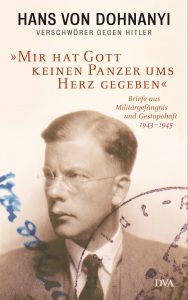 Dohnanyi had been trained as a constitutional lawyer and had held significant posts in the Ministry of Justice. But he had early on become dismayed at the illegal activities and political violence of the Nazi extremists and had in fact drawn up a dossier which documented these misdeeds in full detail.
Dohnanyi had been trained as a constitutional lawyer and had held significant posts in the Ministry of Justice. But he had early on become dismayed at the illegal activities and political violence of the Nazi extremists and had in fact drawn up a dossier which documented these misdeeds in full detail. 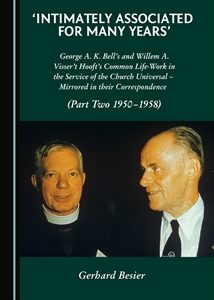 The exchanges by post or telegrams recorded in these volumes are largely drawn from the Geneva archives of the World Council of Churches or from the voluminous Bell papers, now deposited in the Lambeth Palace library in London. The first volume covers the period up to 1949, and the second the final years of Bell’s life up to 1958. The editing by Gerhard Besier is very helpful, since his footnotes give the biographical details of all persons mentioned, as well as bibliographical references to the many scholarly books relating to their endeavors. (There are, however, aggravating lapses in the proof-reading and printing of the English text.) Besier’s introduction is reproduced from the chapter he contributed to The Church and Humanity: The Life and Work of George Bell, 1883-1958 (p. 169-194), edited in 2012 by Andrew Chandler.
The exchanges by post or telegrams recorded in these volumes are largely drawn from the Geneva archives of the World Council of Churches or from the voluminous Bell papers, now deposited in the Lambeth Palace library in London. The first volume covers the period up to 1949, and the second the final years of Bell’s life up to 1958. The editing by Gerhard Besier is very helpful, since his footnotes give the biographical details of all persons mentioned, as well as bibliographical references to the many scholarly books relating to their endeavors. (There are, however, aggravating lapses in the proof-reading and printing of the English text.) Besier’s introduction is reproduced from the chapter he contributed to The Church and Humanity: The Life and Work of George Bell, 1883-1958 (p. 169-194), edited in 2012 by Andrew Chandler.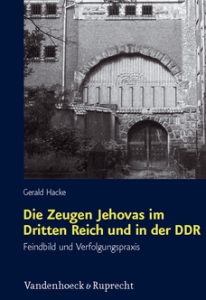 Much of the scholarly literature about the Jehovah’s Witnesses has been conditioned by the harassment and persecution which this sect endured during the period of Nazi rule after 1933. Most of the authors have displayed sympathy with the Witnesses’ sufferings and pay tribute to their enduring loyalty to their faith. Gerald Hacke, however, is principally interested in the actions of the state authorities, and the organization of the various methods of repression which took such a toll. Furthermore he has noted that the same kind of repression was carried out in the post-1945 years in what became known at the German Democratic Republic (GDR) under the aegis of the Communist rulers of that part of Germany for the next 40 years. His large-scale account is therefore mainly a comparison of the similarities as well as the differences in the treatment of this minority religious group by the two ideologically opposed dictatorships. In so doing he has delved in to the vast amount of state documentation left behind by both regimes, particularly in their police and judicial records and the files of the various government ministries who attempted to bring the Jehovah’s Witnesses to heel.
Much of the scholarly literature about the Jehovah’s Witnesses has been conditioned by the harassment and persecution which this sect endured during the period of Nazi rule after 1933. Most of the authors have displayed sympathy with the Witnesses’ sufferings and pay tribute to their enduring loyalty to their faith. Gerald Hacke, however, is principally interested in the actions of the state authorities, and the organization of the various methods of repression which took such a toll. Furthermore he has noted that the same kind of repression was carried out in the post-1945 years in what became known at the German Democratic Republic (GDR) under the aegis of the Communist rulers of that part of Germany for the next 40 years. His large-scale account is therefore mainly a comparison of the similarities as well as the differences in the treatment of this minority religious group by the two ideologically opposed dictatorships. In so doing he has delved in to the vast amount of state documentation left behind by both regimes, particularly in their police and judicial records and the files of the various government ministries who attempted to bring the Jehovah’s Witnesses to heel.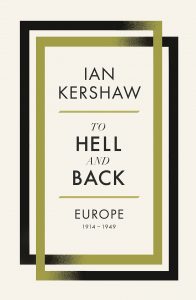 Despite its theologically-sounding title, this latest work by Ian Kershaw, who is one of Britain’s most distinguished contemporary historians, is a masterly synoptic history of Europe, designed for the general reader. In this work, Kershaw expands on his previous interest in Nazi Germany to cover what he calls Europe’s “era of self-destruction,” which places Nazi Germany in its wider context of a continent-wide series of disasters in the first half of the twentieth century. Nevertheless he also includes a short but valuable section on “Christian Churches, Challenge and Continuity”, placing emphasis on the political and social developments affecting the Christian churches within the wider European setting.
Despite its theologically-sounding title, this latest work by Ian Kershaw, who is one of Britain’s most distinguished contemporary historians, is a masterly synoptic history of Europe, designed for the general reader. In this work, Kershaw expands on his previous interest in Nazi Germany to cover what he calls Europe’s “era of self-destruction,” which places Nazi Germany in its wider context of a continent-wide series of disasters in the first half of the twentieth century. Nevertheless he also includes a short but valuable section on “Christian Churches, Challenge and Continuity”, placing emphasis on the political and social developments affecting the Christian churches within the wider European setting.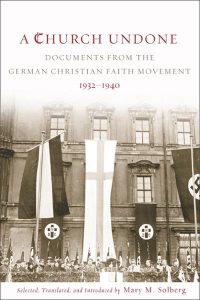 Despite the excellent contributions of such authors as James Zabel, Doris Bergen and Robert Ericksen, Solberg feels that “far too few people in or out of the academy know far too little“ about the conduct of the churches In Hitler’s Germany. But her extended introduction clearly indicates her approach to answering the questions posed by her documents: specifically what role did this German Christian Faith Movement play in the wider picture; how successful or significant were its supporters in the rise and maintenance of Nazism, at least up to 1940; and how should Christians and churches today learn from this example of a church undone? Her skillful translations of the writings of several prominent members of this movement will be of considerable value to those who do not read German, but it would have been helpful to have a biographical note or appendix outlining the careers of these authors. Her conclusion is that this was not a unique episode, that the conflation of political, racist and nationalist ideas with theological witness is a constant temptation, and therefore that the German experience in the 1930s deserves further study by both theologians and historians.
Despite the excellent contributions of such authors as James Zabel, Doris Bergen and Robert Ericksen, Solberg feels that “far too few people in or out of the academy know far too little“ about the conduct of the churches In Hitler’s Germany. But her extended introduction clearly indicates her approach to answering the questions posed by her documents: specifically what role did this German Christian Faith Movement play in the wider picture; how successful or significant were its supporters in the rise and maintenance of Nazism, at least up to 1940; and how should Christians and churches today learn from this example of a church undone? Her skillful translations of the writings of several prominent members of this movement will be of considerable value to those who do not read German, but it would have been helpful to have a biographical note or appendix outlining the careers of these authors. Her conclusion is that this was not a unique episode, that the conflation of political, racist and nationalist ideas with theological witness is a constant temptation, and therefore that the German experience in the 1930s deserves further study by both theologians and historians.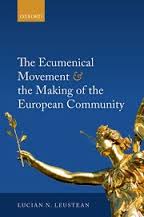 To be sure the tasks of European reconstruction and reconciliation were formidable for politicians and churchmen alike. Priority had to be given to the immense task of caring for the vast millions of bombed-out, brutalized, and displaced populations. Most churches were still tied to their own national affairs and regarded plans for European integration as lying outside their spiritual domain. However a few of the survivors of the pre-war ecumenical bodies, led by the valiant and dynamic personality of the Dutch Calvinist, Visser ‘t Hooft, General Secretary of the World Council of Churches, recognized the importance of seeking closer relations with those politicians involved in European reconstruction. The World Council, which achieved its long-delayed inauguration in 1948, almost immediately suffered a grievous, if not unexpected, blow by the rejection of its invitation to the Vatican to have Roman Catholics as full members. The initiative in European affairs was therefore left to the Anglicans, the Protestant leaders of northern Europe, and a handful of Orthodox churchmen in Eastern Europe. So too, those politicians who had expected that the legacy of unbridled nationalism under Hitler would lead to a willingness to cooperate more closely in pan-European revival were soon to be disappointed by the brusque refusal of the Soviet government to entertain any such measures for the areas of Eastern Europe under its military control. In both the political and religious fields, therefore, expectations had to be cut down, and prognoses for European integration modified, often drastically.
To be sure the tasks of European reconstruction and reconciliation were formidable for politicians and churchmen alike. Priority had to be given to the immense task of caring for the vast millions of bombed-out, brutalized, and displaced populations. Most churches were still tied to their own national affairs and regarded plans for European integration as lying outside their spiritual domain. However a few of the survivors of the pre-war ecumenical bodies, led by the valiant and dynamic personality of the Dutch Calvinist, Visser ‘t Hooft, General Secretary of the World Council of Churches, recognized the importance of seeking closer relations with those politicians involved in European reconstruction. The World Council, which achieved its long-delayed inauguration in 1948, almost immediately suffered a grievous, if not unexpected, blow by the rejection of its invitation to the Vatican to have Roman Catholics as full members. The initiative in European affairs was therefore left to the Anglicans, the Protestant leaders of northern Europe, and a handful of Orthodox churchmen in Eastern Europe. So too, those politicians who had expected that the legacy of unbridled nationalism under Hitler would lead to a willingness to cooperate more closely in pan-European revival were soon to be disappointed by the brusque refusal of the Soviet government to entertain any such measures for the areas of Eastern Europe under its military control. In both the political and religious fields, therefore, expectations had to be cut down, and prognoses for European integration modified, often drastically.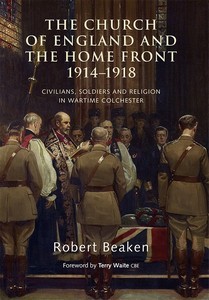 Colchester’s social elite, which was well represented in the Church of England parishes, was conservative, nationalist and hierarchical. Its members supported the British government’s decision to go to war in August 1914 for moral as well as political reasons. They joined in the widespread campaign urging young men to join the armed forces, until conscription was introduced in 1916, rendering such appeals superfluous. Thereafter the leading men set an example by supporting campaigns for contributions to the War Savings Bonds, while the church ladies were very active in ministering to the troops training in Colchester and to the wounded. Church people were assiduous in providing hospitality to the troops, and at least thirty five social clubs were established where recreational facilities and food were supplied, often at little cost. In part such provision was seen as a Christian virtue, but, as Beaken notes, in part it was inspired by the desire to keep the soldiers out of public houses, and so to keep prostitution and its attendant problems at bay.
Colchester’s social elite, which was well represented in the Church of England parishes, was conservative, nationalist and hierarchical. Its members supported the British government’s decision to go to war in August 1914 for moral as well as political reasons. They joined in the widespread campaign urging young men to join the armed forces, until conscription was introduced in 1916, rendering such appeals superfluous. Thereafter the leading men set an example by supporting campaigns for contributions to the War Savings Bonds, while the church ladies were very active in ministering to the troops training in Colchester and to the wounded. Church people were assiduous in providing hospitality to the troops, and at least thirty five social clubs were established where recreational facilities and food were supplied, often at little cost. In part such provision was seen as a Christian virtue, but, as Beaken notes, in part it was inspired by the desire to keep the soldiers out of public houses, and so to keep prostitution and its attendant problems at bay.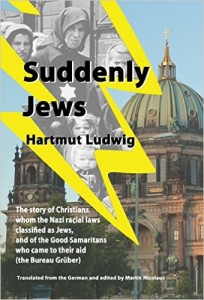 When Hitler came to power in 1933, the majority of German Protestants loyally supported him, believing his promises to restore Germany’s place in the world, and to save them from the danger of Communist revolution. His rabble-rousing attacks on the Jews were dismissed as mere propaganda, which would be abandoned once the regime settled into power. But in fact the Nazis only increased their anti-Semitic campaigns, both by executive decree and by legislation, leading to the vicious outbursts of November 1938, known as the Kristallnacht. Grievously affected were those in the Protestant churches who now found they were classified as Jews on racial grounds, regardless of the fact that they or their parents had converted to Christianity in earlier years. They could expect no help from the pro-Nazi authorities in the majority of Protestant churches. Only in the minority Confessing Church were to be found some men and women who rallied to their support. In the crucial circumstances in later 1938, the Provisional Leadership of the Confessing Church selected a Berlin pastor, Heinrich Grüber, to organize relief efforts for these Protestants of Jewish origin throughout the country. He set up his own independent office, and immediately began to search out opportunities for those affected to emigrate. At the same time, he sought to provide assistance to those who could not or were not willing to leave the country. But in 1940 this assistance was halted by the Gestapo. Grüber’s chief assistant was murdered, along with fourteen other helpers deported to extermination camps. Fortunately, Grüber himself survived and continued his ministry in post-war Berlin.
When Hitler came to power in 1933, the majority of German Protestants loyally supported him, believing his promises to restore Germany’s place in the world, and to save them from the danger of Communist revolution. His rabble-rousing attacks on the Jews were dismissed as mere propaganda, which would be abandoned once the regime settled into power. But in fact the Nazis only increased their anti-Semitic campaigns, both by executive decree and by legislation, leading to the vicious outbursts of November 1938, known as the Kristallnacht. Grievously affected were those in the Protestant churches who now found they were classified as Jews on racial grounds, regardless of the fact that they or their parents had converted to Christianity in earlier years. They could expect no help from the pro-Nazi authorities in the majority of Protestant churches. Only in the minority Confessing Church were to be found some men and women who rallied to their support. In the crucial circumstances in later 1938, the Provisional Leadership of the Confessing Church selected a Berlin pastor, Heinrich Grüber, to organize relief efforts for these Protestants of Jewish origin throughout the country. He set up his own independent office, and immediately began to search out opportunities for those affected to emigrate. At the same time, he sought to provide assistance to those who could not or were not willing to leave the country. But in 1940 this assistance was halted by the Gestapo. Grüber’s chief assistant was murdered, along with fourteen other helpers deported to extermination camps. Fortunately, Grüber himself survived and continued his ministry in post-war Berlin.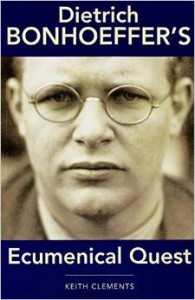 In fact, Bonhoeffer’s participation in ecumenical affairs started immediately after his return in September 1931 from his visit to the United States. He was sent as a German youth delegate to a meeting in Cambridge of the World Alliance for Promoting International Friendship through the Churches. This body had originally been established in 1914, but had to suspend its activities during the war, and had only been resuscitated in 1920. Its support came from influential lay and clerical leaders, particularly in the democratic countries of Western Europe and North America. They recognized the need for programs of reconciliation and peace activities in order to bind up the wounds caused by the destructive violence of the recent war. It was here that Bonhoeffer met with such leading figures as the Anglican Bishop George Bell of Chichester, with whom he was to collaborate for the next decade.In fact, Bonhoeffer made such an impact that he was forthwith appointed as an Honorary Youth Secretary and given responsibility for the World Alliance’s youth work in central Europe. This was a challenge he could hardly refuse, and one to which he brought his newly-minted skills in theological advocacy and his energetic support of the World Alliance’s aims.
In fact, Bonhoeffer’s participation in ecumenical affairs started immediately after his return in September 1931 from his visit to the United States. He was sent as a German youth delegate to a meeting in Cambridge of the World Alliance for Promoting International Friendship through the Churches. This body had originally been established in 1914, but had to suspend its activities during the war, and had only been resuscitated in 1920. Its support came from influential lay and clerical leaders, particularly in the democratic countries of Western Europe and North America. They recognized the need for programs of reconciliation and peace activities in order to bind up the wounds caused by the destructive violence of the recent war. It was here that Bonhoeffer met with such leading figures as the Anglican Bishop George Bell of Chichester, with whom he was to collaborate for the next decade.In fact, Bonhoeffer made such an impact that he was forthwith appointed as an Honorary Youth Secretary and given responsibility for the World Alliance’s youth work in central Europe. This was a challenge he could hardly refuse, and one to which he brought his newly-minted skills in theological advocacy and his energetic support of the World Alliance’s aims.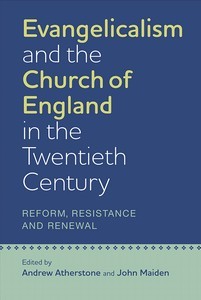 The opening chapter, written by two Oxford scholars, examines the taxonomy of recent English Evangelicalism, describing the various strands within this spectrum of belief, which share common features in their adherence to the key truths of justification by faith alone and the supreme authority of Holy Scripture as the word of God. Nevertheless each of these strands places its emphasis on different aspects of the faith. Conservative Evangelicals stress the inerrancy of the Bible and refuse to accept the scientific evidence for evolution. More “open” Evangelicals have accepted both the modern theories about the world’s origins and many of the findings of biblical criticism, while most recently the contribution of the charismatic movement, drawn from Pentecostalism, and found in such London churches as Holy Trinity, Brompton or St Paul’s, Onslow Square, has reinvigorated and popularized Evangelicalism among young people. The rivalries—and sometimes the acerbic criticisms of these groups of each other—have meant that English evangelicalism often seems to have been in a constant process of reconfiguration.
The opening chapter, written by two Oxford scholars, examines the taxonomy of recent English Evangelicalism, describing the various strands within this spectrum of belief, which share common features in their adherence to the key truths of justification by faith alone and the supreme authority of Holy Scripture as the word of God. Nevertheless each of these strands places its emphasis on different aspects of the faith. Conservative Evangelicals stress the inerrancy of the Bible and refuse to accept the scientific evidence for evolution. More “open” Evangelicals have accepted both the modern theories about the world’s origins and many of the findings of biblical criticism, while most recently the contribution of the charismatic movement, drawn from Pentecostalism, and found in such London churches as Holy Trinity, Brompton or St Paul’s, Onslow Square, has reinvigorated and popularized Evangelicalism among young people. The rivalries—and sometimes the acerbic criticisms of these groups of each other—have meant that English evangelicalism often seems to have been in a constant process of reconfiguration.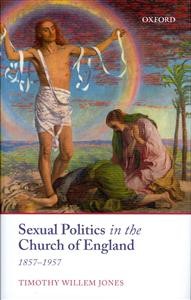 Timothy Jones follows this lead by undertaking a study of the major changes in gender politics in the Church of England from the mid-nineteenth to the mid-twentieth century. He focusses on six episodes during this period which, he claims, demonstrated the often reluctant posture of the church leaders when challenged to take a stand on matters affecting gender or sexual politics. Over the course of this hundred year span, English society evolved rapidly and adopted a much more liberal stance, which was often reflected in parliamentary debates, and found its way into progressive legislation. The result was a frequent clash of interest with the more conservative and traditional sectors of opinion, including those of the Church of England. Jones begins his survey with the debates about marriage in the mid-1850s and concludes with the heated controversies about consensual homosexuality in the 1950s. Rather than indulging in detailing the reactionary attitudes of some Church of England leaders, Jones skillfully weaves into his account the variety of positions taken over the years, and displays a commendable sympathy for most of the participants in this on-going search for new understandings amongst church members about gender and sexual politics.
Timothy Jones follows this lead by undertaking a study of the major changes in gender politics in the Church of England from the mid-nineteenth to the mid-twentieth century. He focusses on six episodes during this period which, he claims, demonstrated the often reluctant posture of the church leaders when challenged to take a stand on matters affecting gender or sexual politics. Over the course of this hundred year span, English society evolved rapidly and adopted a much more liberal stance, which was often reflected in parliamentary debates, and found its way into progressive legislation. The result was a frequent clash of interest with the more conservative and traditional sectors of opinion, including those of the Church of England. Jones begins his survey with the debates about marriage in the mid-1850s and concludes with the heated controversies about consensual homosexuality in the 1950s. Rather than indulging in detailing the reactionary attitudes of some Church of England leaders, Jones skillfully weaves into his account the variety of positions taken over the years, and displays a commendable sympathy for most of the participants in this on-going search for new understandings amongst church members about gender and sexual politics.